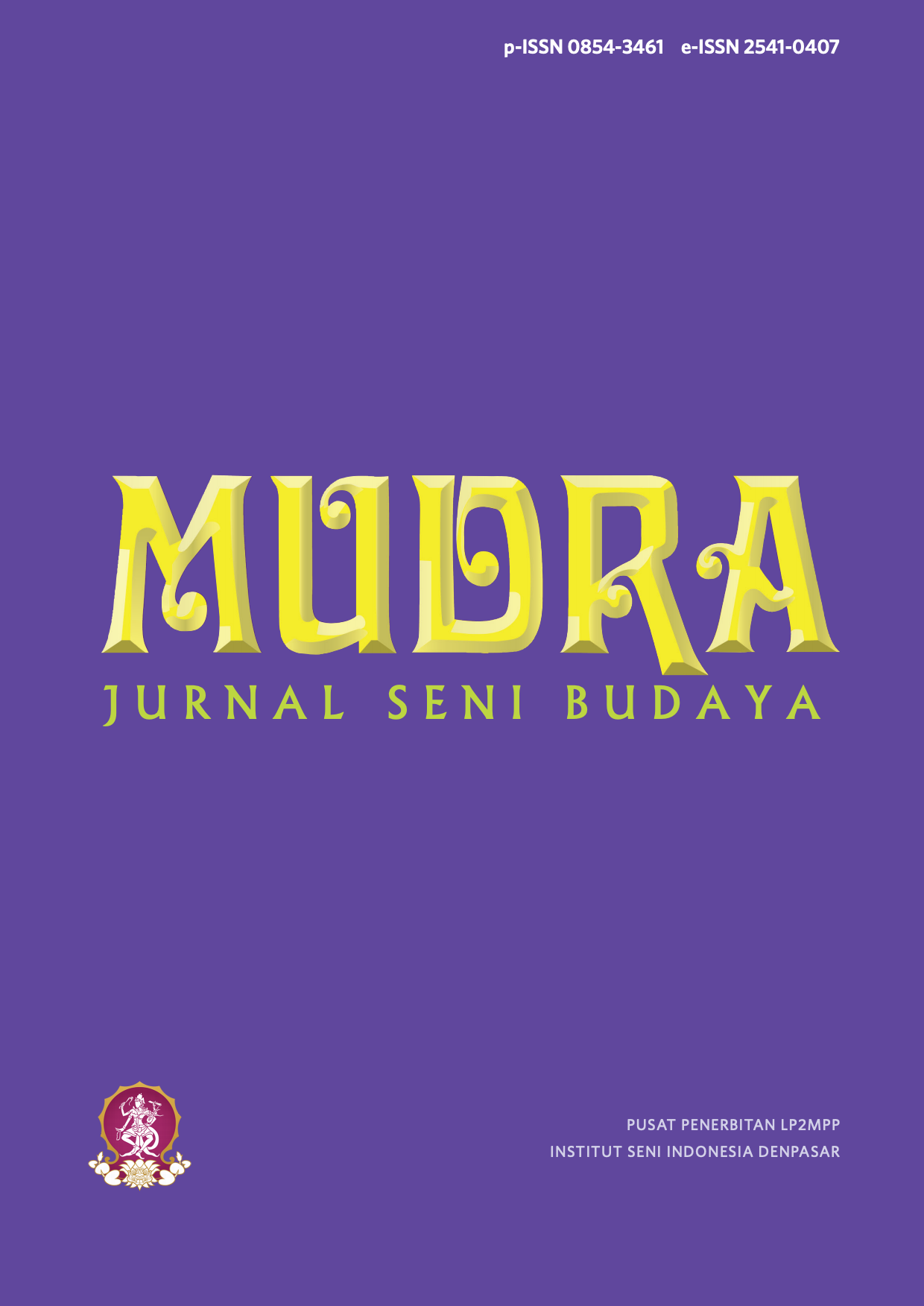Respons Emotional Well-Being Dalam Laras Gamelan Jawa
DOI:
https://doi.org/10.31091/mudra.v22i1.1549Keywords:
psychology of music, slendro, pelog, emotional well- beingAbstract
The aim of these research is to study the effects of laras toward the listener emotional well-being. From the psychology of music point of view, this research attempts to understand the emo- tional well-being of the listeners. These study may be primarily cog- nitive or may consist of the frequency with which listener expe- rienced pleasant and unpleasant emotions. The samples were every- one whose have an experienced on listening the gamelan in their everyday life. Through quasi-experiment and purposive sampling, the 73 samples listened to two songs that composed in slendro nem and pelog lima’s scale and also interviewed in focus group discus- sions. The results shown that the pelog’s scale influenced more to the emotional well-being of the listeners than slendro’s scale.
Downloads
References
Azwar. 1996. Penyusunan skala sikap. Yogyakarta: Pustaka Pelajar.
Becker, J. 2001. Anthropological perspectives on music and emotion. In.P.N.Juslin & J.A. Sloboda (Eds.), Music and emotion: Theory and research (pp.135- 60). NY: Oxford University Press.
Benamou, M. 2001. Rasa in javanese musical aesthetics. PhD dissertation: Musicology. Ann Arbor, MI: Michigan Univsersity Press.
Boski,P., van de Vijver,F.J.R., & Chodynicka,A.M. (Eds.). 2002. New directions in cross-cultural psychology. Warsawa: Polish Psychological Association. Brannen,J. (Ed.). 1992. Mixing methods: qualitative and quantitative research. Aldershot: Avebury
Buck,R,1986. The psychology of emotion. In Mind and brain,ed. J. LeDoux and
W.Hirst, 275-300.Cambridge: Cambridge University Press
Darwin, C. 1871. The origin of species and the descent of man. NY: Modern Library.
De Nora,T.1997. Music and erotic agency-sonic resources and social-sexual action. Body and Society, 3, 43-65.University Press.
Djohan, 2003. Psikologi Musik. Buku Baik: Yogyakarta.
Dowling, W. J. & Harwood, D.L. 1986. Music cognition. NY: Academic Press. Hadi, S. 1983. Metodologi Penelitian . Yogyakarta: Penerbit Andi Offset
Hall, S.1989. A molecular code links emotions, mind, and health. Smithsonian, June,62-71.
Jansma, M, & Vries, Bart de.1995. Muziek en emotie. In: Evers, Jansma, Mak, De
Vries (Eds). Muziekpsychologie. (pp. 204-222). Assen: Van Gorcum.
Juslin, P.N. & Sloboda, J.A. 2001. Music and emotion: theory and research.NY. Oxford University Press.
Koentjaraningrat. 1994. Kebudayaan Jawa. Jakarta : Penerbit Balai Pustaka. Madsen,C.,R.Brittin, and D. Capperella-Sheldon.1993. An empirical method for measuring theaesthetic experience to music. Journal of Research in Music Education 41, no.1:57-69.
Magnis-Suseno, F. 1999. Etika Jawa. Sebuah analisa falsafi tentang kebijaksanaan Hidup Jawa. Jakarta: PT. Gramedia Pustaka Utama.
Markam, S. S. 1994. Pengalaman Emosi dan Kesehatan Mental. Pidato Pengukuhan. Diucapkan pada Upacara Penerimaan Jabatan sebagai Guru Besar Tetap Psikologi pada Fakultas Psikologi Universitas Indonesia di Jakarta tanggal 15 Juni 1994.
Merriam, A.P.1964. The anthropology of music. Evanston,IL: Northwestern University Press.
Mulder,N. 2001. Mistisisme Jawa Ideologi Indonesia. Yogyakarta: Lkis.
Peretz, I & Gagnon,L. 2000. Laterality effects in processing tonal and atonal melodies with affective and non affetive task instruction. Brain and cognition, 43, 206-10.
Santrock. J.W. 2006. Life-span development. Wm.C. Brown Communications, Inc. Sloboda,J.A. 1992. Empirical studies of musical affect. In M. Riess-Jones & S.
Hollerman (Eds.). Cognitive bases of musical communication (pp. 33-45). Washington: American Psychological Association.
_________ 2001. Everyday uses of music listening: a preliminary study. In S. W. Yi (Ed.), Music, Mind and Science. Seoul: Western Music Research Institute.
Suryabrata, S. 2000. Pendekatan kuantitatif dan kualitatif: Makalah pidato pelepasan guru besar fakultas Psikologi Universitas Gadjah Mada (tidak diterbitkan). Yogyakarta.
Wundt, W. 1897. Outlines of psychology (trans,C.H.Judd). Leipzig: Englemann.
Downloads
Published
How to Cite
Issue
Section
License
Copyright (c) 2008 Author(s)

This work is licensed under a Creative Commons Attribution-NonCommercial-ShareAlike 4.0 International License.
- Copyright on any open access article in a journal published by Mudra Jurnal Seni Budaya is retained by the author(s).
-
The Creative Commons Attribution License 4.0 formalizes these and other terms and conditions of publishing articles.






